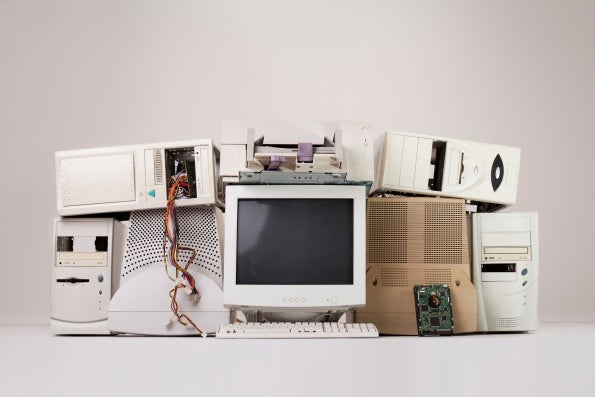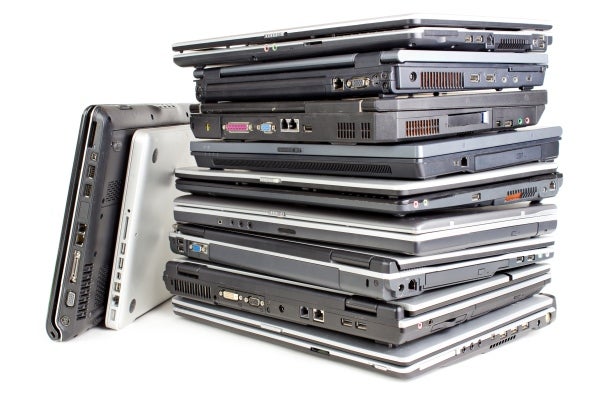Most small businesses refresh their desktops and laptops every three to five years, but that process brings up a thorny question: What should you do with the old equipment? Answer: learn how to repurpose old PCs and laptops.
But wait; why not donate those old PCs and laptops to a local school or charity that could use them? After all, the hardware is still functional, just a little slow. However, donating old PCs to charity often isn’t as easy as you might think.
[Don’t miss out on more open source goodness: Top Open Source Firewalls for Small Business]
First, you need to consider the security risk. You have to make absolutely certain to thoroughly erase any business or customer data on the drives. And just deleting the files won’t work. Criminals can and do try to recover data from discarded and donated PCs. If you haven’t used specialized software to “shred” your old files, you’re putting your company at risk of data theft.
Recovering from data theft can be really expensive. According to the Ponemon Institute, each lost or stolen customer record costs companies an average of $158. If thieves steal thousands of records, the total cost adds up quickly. In addition, many charities have been so flooded with old PC hardware that they no longer accept these kinds of donations, especially if the systems are more than a year or two old.
Facing those realities, you might decide to just throw away your old equipment. However, throwing away old hardware does nothing to eliminate the security risk, and in many areas, it’s actually illegal. PCs contain toxic materials like lead, arsenic, mercury, berylium and cadmium, which pose a very real threat to the environment. Consequently, many communities don’t allow people to send electronics to the landfill, and even if it isn’t against the law, it isn’t environmentally responsible.
If the landfill isn’t an option, how about recycling? Often, this is the best option, but it’s neither care- nor hassle-free. Some PC manufacturers offer recycling programs, but many don’t. It can be very difficult to find a reputable recycling firm that charges reasonable rates, and the process can be time-consuming and frustrating. And even your best recycling intentions can end badly. Consider this chilling story—Following The Trail Of Toxic E-Waste—that 60 Minutes ran in 2008.
How to Repurpose Old PCs and Laptops
As a result, a lot of small businesses have a closet somewhere that is full of old computers and related junk, and no one knows what to do with it. However, The open source community has created a number of projects that can breathe new life into aging PCs. Here are five ways to repurpose old laptops and PCs. And don’t worry; they’re within the realm of possibility for small businesses with a small (or non-existent) IT staff.
1. Turn Your Old PC into a Network Security Appliance
You may have considered buying a specialized network firewall or gateway security appliance from a vendor like Barracuda, Cisco, or SonicWall. These products do a good job of protecting your network, but they can cost hundreds of dollars.
Another option is to create your own network security appliance using one of your old PCs. Two products make the process fairly easy:
- Endian Firewall Community installs on most X86 hardware (that is, a standard PC, laptop, or server with an Intel or AMD processor), and it includes a firewall, basic Web and email security, antivirus protection, and a virtual private network (VPN) for securely connecting to the network from off-site. The free version, recommended for home rather than business use, might not meet the needs of larger businesses. But if you own a very small or micro-business, this option probably offers all the security you need.
- Untangle NG Firewall Free bundles together a firewall and other free security apps “pre-configured for the needs of small business.” The company also offers a variety of paid products, but if you have an old PC, you can install the open source version of the software for free.
2. Set Up a Small Business Server
If you’re repurposing and old laptop or PC with a fairly large hard drive, you can use it for more than just network security. For example, you could install ClearOS Community. This application combines security features like a firewall, intrusion detection, and a content filter with networking features like bandwidth management, and a domain controller. It also includes a file and print server (that lets you share files and printers across your network), a Web server for hosting your website, and more.
Koozali SMEServer offers a similar set of features: file and print sharing, easy Internet connection, email, antivirus and antispam, firewall, remote access, directory services, Web hosting, storage, and backup. Most businesses can install it and be up and running in less than twenty minutes.
3. Repurpose an Old PC with Desktop Linux
If you don’t need a networked server, consider repurposing an old PC by installing desktop Linux. If, for example, you have an old Windows XP desktop or laptop in your office that you didn’t (or couldn’t) upgrade to one of the newer versions of Windows, you could install one of the lightweight Linux distributions on it.
Microsoft no longer updates security patches for the Windows XP operating system, which means that XP desktops and laptops pose a big security risk. But Linux doesn’t have those same issues or the related security risk.
Linux comes in hundreds of different versions called “distributions” or “distros” for short. That can confuse people who are new to open source software, but the advantage is that you have a really good chance of getting an operating system that does exactly what you want. Plus, most Linux distros include lots of built-in software, so you don’t have to pay extra for an office productivity suite or other software. And if you have Windows applications that you want to run, you can use a program called WINE to make that possible.
If you want to install Linux on a really old desktop or laptop (like one with Windows XP), consider one of the lightweight distributions, such as Lubuntu or LXLE. These can run on systems with slower processors, less memory, and smaller hard drives. If you want an operating system that looks and feels a lot like the Windows you’re used to using, consider Linux Mint or Zorin OS, both of which are specifically designed for new Linux users.
4. Build Your Own Data Storage Solution
You could also repurpose your old PC to host your own cloud storage service. The aptly named OwnCloud lets you turn any x86-based hardware into a secure server for sharing files, music, photos, calendars, contacts, mail, and other data so that you and your employees can access it from any device. If you consider yourself fairly technical, you can use the documentation on the OwnCloud website to get started. If you’re not so technical, download the OwnCloud image from Turnkey Linux (see option number 5 below) to simplify the process.
If you like the idea of repurposing your old PC for file storage, but you don’t want the system connected to the Internet, then consider using FreeNAS. It can turn that old PC into a network attached storage (NAS) device that lets all the systems connected to your network share files. It helps protect your data with RAID technology that automatically copies all of your files, making it possible—in some cases—to get your data back if your hardware fails. To complete the installation, you will also need a USB thumb drive, but the process is fairly simple.
5. Create Another Type of Server or Appliance.
Maybe you don’t need a security appliance or a small business server or storage, but you could use a server to host your website, blog, wiki, ecommerce site, data backups, customer relationship management (CRM) software, or some need that we haven’t mentioned.
In that case, you should check out Turnkey Linux. This website has more than a hundred options for easy-to-deploy free software that “just works.” You look for the type of software project you need—backup, ecommerce, blogging, content management, etc.—download the image and install it on your old desktop or laptop. It gives you everything you need to get up and running in just minutes.
[Don’t miss this article on open source software: Open Source Accounting Software for Small Business]
One More Option—Data Destruction
Finally, if none of these options for repurposing an old PC sounds appealing, we have one more open source tool for you. It’s called Darik’s Boot and Nuke, or DBAN. You download the software onto a CD or a USB drive. When you insert the CD or USB drive into a desktop or laptop and turn on the system, DBAN completely eliminates the data on the hard drive, writing over the data on the drive several times so that it can’t be recovered.
If you’re going to recycle your old PC or send it to the landfill—or even if you’re going to leave it in the closet for a while longer—run DBAN first to protect your business and your customers against data theft.
Cynthia Harvey is a freelance writer and editor based in the metro Detroit area. She has been covering the technology industry for more than 15 years.
| Do you have a comment or question about this article or other small business topics in general? Speak out in the SmallBusinessComputing.com Forums. Join the discussion today! |



